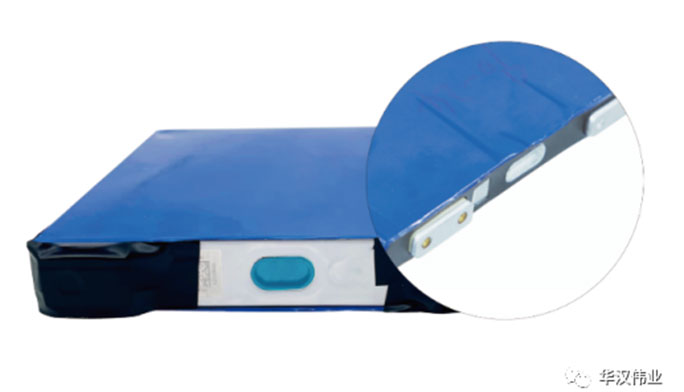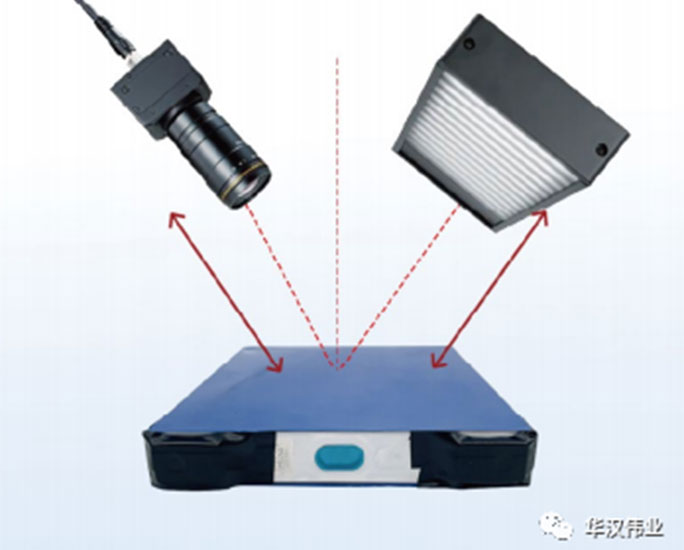
With the advent of the TWH era, major terminals are rapidly expanding production, and the requirements for battery manufacturing processes are also increasing. From front-end electrode manufacturing to back-end module assembly, almost all workstations use visual inspection technology, especially in the cell manufacturing process section, such as weld inspection for sealing nails, weld inspection for top cover welding, and appearance inspection after blue film coating, which are all pain points and difficulties in the industry.
In response to the pain points in these industries, Huahan Weiye has organized special research and development to overcome them, and has launched a detection method that deeply integrates 2D/3D vision technology, 2.5D imaging technology, and AI. This article takes the appearance defect detection of battery pack blue film as an example, focusing on introducing that Huahan Weiye uses 2.5D+AI to solve industrial testing difficulties.
Coating blue film is an important process in the production of power batteries. Blue film, also known as isolation film, anti film, protective film, etc., comes in various colors such as red, green, blue, white, black, etc. It is divided into single-sided release film and double-sided release film. Blue film is usually used in power batteries.
As an insulating material, the blue film separates the battery cells from each other, blocking the impact of various faults on other cells and preventing "all damage.". The thickness of the blue film is small, only between 0.015mm and 0.20mm. During the production process, defects such as scratches, damage, and wrinkles are prone to occur. Some of these defects can affect the appearance of the product, while others may even damage its functionality.
Moreover, the optical properties of the blue film itself make many defect features unclear, and traditional algorithms have extremely high kill and miss rates; There are numerous types of defects and some samples of defect types are difficult to collect; The appearance inspection of blue film is a major pain point in the industry, and it is difficult to solve the application scenario where bubbles appear in the blue film if only traditional line scanning imaging or deep learning is used in the inspection.

(Original image display)
1) Bubbles with a diameter greater than 2mm are formed on the surface of the capsule;
2) Wrinkles and scratches with a length greater than 2mm;
3) The edge of the capsule is uneven/cracked/dirty/torn.
3.Solution
Software: Huahan AIDI Suite Deep Learning Intelligent Detection System
Hardware: 2.5D linear array camera+2.5D dedicated LED light source

(Lighting diagram)
1) Huahan Weiye uses 2.5D imaging technology to perform convolution operations on multiple images and extract common features by inputting shape images, diffuse reflection images, and grayscale images. The segmentation module in AI can automatically resample defect areas, improve attention to small defects, and achieve accurate detection of small defects. 2.5D+AI can effectively solve the defects of small bubbles and fiber scratches.
2) The scanning speed is 300mm/s, the detection time is 2.5s, and the accuracy of detecting the diameter of bubbles can reach 0.06mm. The missed detection rate is zero, and the kill rate is< 1%, its detection rate is better than the production rate, breaking through the bottleneck of insufficient detection ability to further increase production.

(Presentation of renderings)
Huahan Weiye is dedicated to high-precision measurement and defect detection of large workpieces. It adopts a 2D/2.5D/3D/+AI visual detection method, and its self-developed AI core algorithm functions support source code programming, small sample learning, and can recognize irregular object defects. AI detection can solve the traditional space between methods, reduce product misjudgment rates, support continuous code development mode, integrate 2D, 2.5D, and 3D images, and support small sample learning. When the production line is in a market state, it can achieve production line running volume through training with a very small number of samples.
Huahan Weiye has been deeply involved in the lithium battery industry since its establishment, with decades of industry accumulation. It has a self-developed core algorithm MVDevelop platform, which can benchmark against foreign first-class algorithm libraries. Based on the self-developed core algorithm, it has developed 2D/3D/AI visual software with independent intellectual property rights, and also provides standard visual components and complete industry solutions. Currently, 3D/AI visual software has been widely applied in the fields of 3C electronics and new energy.